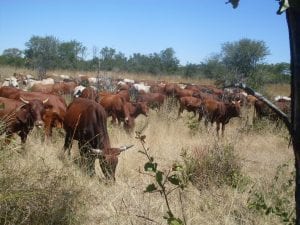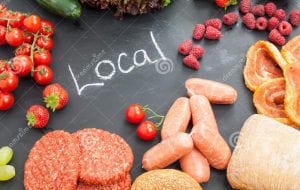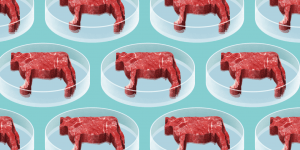A brief insight
A UN panel of scientists last week announced that we have 12 years to limit the devastating effects of our carbon emissions. The report stated that we have to perform a spectacular U-turn back to post-industrial revolution levels to prevent a temperature rise of 1.5C.
Now those of us that live in bonnie Scotland might feel that a temperature increase sounds quite nice, that we have just had a lovely, record breaking summer – the 16th consecutively – and that 16 more might be grand, but sadly the news is not all beach holidays and summer cheer. This rise in temperature presents a catastrophic issue for not just humanity, but much of the life on our planet – the only one we have.
This article focuses mainly on food production and the issues of livestock, not only because I am a voracious eater, and shameful carnivore keen to find an environmentally sound alternative, if possible, but because to tackle the topic as a whole, would require months of research and a knowledge of global economics and policy far beyond my paltry grasp.
An increasingly warm planet is not the worst of it, maybe, unfortunately for all us carnivores, meat is an inefficient way to feed humanity in this day and age; what with the amount of space required, and the environmental effect of livestock. In fact it is thought that around 15% of our carbon emissions come from meat production, and it takes up roughly 83% of Earth’s available farmland.
On top of that, it is predicted that we could feed an additional 3.5 billion people if we ate the food grown for livestock.
So, is veganism the only way to efficiently feed our ever growing population now, and for the future?
More is less
 A Zimbabwean ecologist and rancher, Allan Savory, gave a Ted talk entitled “How to fight desertification and reverse climate change” the brass balls of which grabbed my attention and 5 million views since 2013. During his talk he introduces the idea of “holistic management” for livestock which helps to increase soil retention of carbon, and promote the growth of healthy vegetation through, planned and responsive, intense grazing with greater numbers of livestock.
A Zimbabwean ecologist and rancher, Allan Savory, gave a Ted talk entitled “How to fight desertification and reverse climate change” the brass balls of which grabbed my attention and 5 million views since 2013. During his talk he introduces the idea of “holistic management” for livestock which helps to increase soil retention of carbon, and promote the growth of healthy vegetation through, planned and responsive, intense grazing with greater numbers of livestock.
He suggested that by using his method to decrease the size of deserts we could not only reduce global hunger, but massively reduce our carbon footprint.
The idea was revolutionary, and a meat eater’s dream, but given the complete lack of corroborating scientific evidence it seems unlikely to be the key to a carbon neutral meat industry. The primary advocates for holistic land management appear to be the livestock producers, who would greatly benefit from the method.
Home grown
 “Low-emission cows: farming responds to climate warning” is the title of The Guardian’s recent article on our own meat industry. Primarily on the views of the NFU, or the National Farmers’ Union of England and Wales to you and I, having had an awful year due to weather, the NFU say that farmers are “up for radical thoughts”, which is a little vague, and a tad worrying if you have ever met a farmer.
“Low-emission cows: farming responds to climate warning” is the title of The Guardian’s recent article on our own meat industry. Primarily on the views of the NFU, or the National Farmers’ Union of England and Wales to you and I, having had an awful year due to weather, the NFU say that farmers are “up for radical thoughts”, which is a little vague, and a tad worrying if you have ever met a farmer.
They make the suggestion of breeding the livestock that produce less gas, to lower their emissions, and they are also looking at altering the livestock’s diet to reduce gas. However they are not keen on taxes that might drive people from meat, or from a reduction of land as methods to reduce our footprint.
That said, sourcing your meat from local producers will cut down on the emissions from transport, and hopefully guarantee a better quality meat too.
Lab Grown – clean meat
 To many this concept is unnatural and gross, but the idea of growing meat in a lab is an interesting one. It works by taking animal cells, and growing them in a bio reactor by tricking them into thinking they are still in an animal.
To many this concept is unnatural and gross, but the idea of growing meat in a lab is an interesting one. It works by taking animal cells, and growing them in a bio reactor by tricking them into thinking they are still in an animal.
With clean meat the space used for livestock would be exponentially reduced, it would be morally better, and as such it is even supported by PETA, who traditionally hates everything to do with the meat industry.
However the concept is currently not economically viable, but the companies producing clean meat are currently working to reduce the price of production.
Though it might be a viable option for the future, it is still some way off.
Fish fingers
 A relatively new concept, albeit one that appears to be taking off, is Aquaponics – the marriage of fish farming and indoor crop growth – could be an excellent aid to combat over fishing, and the massive consumption of fresh water by our agricultural industries.
A relatively new concept, albeit one that appears to be taking off, is Aquaponics – the marriage of fish farming and indoor crop growth – could be an excellent aid to combat over fishing, and the massive consumption of fresh water by our agricultural industries.
Aquaponics uses a near self-sustaining ecosystem that produces crops faster than in fields, and with less space required. They also have a by-product of edible fish.
Now this is not a way to keep red meat on the table, but it is working, and it can be done to varying degrees by anyone.
Conclusions
Above are four methods that could prevent our diets from being too heavily altered by the changes we need to make to save ourselves and our home. The first one is likely a ranchers attempt to boost profits, but it is an interesting concept regardless.
Only time will tell if veganism is the only viable path left to us, but for now there are bigger questions than whether our children will have tasted steak.
The real question is can we change enough to ensure that they will be able to breathe clean air, on a planet that is not vastly overpopulated from those fleeing rising tides, and vanishing landmasses.
Ultimately we have a moral, ethical, and environmental decision to make, and it could decide the fate of life as we know it.
No one person stands a chance of changing our current course, but together we can force the hand of corrupt governments, and nudge ourselves into a brighter future.
Meat eaters, cut back, have a day or two free at least, and when you do, shop locally. You never know, you might actually enjoy it.